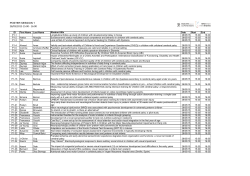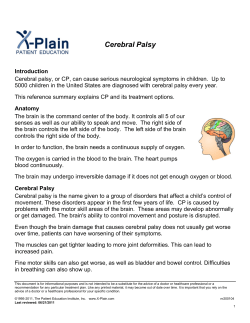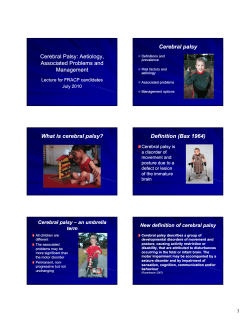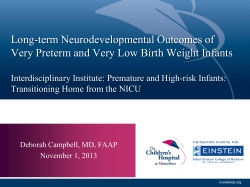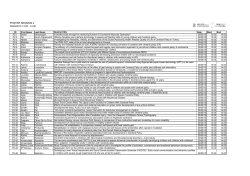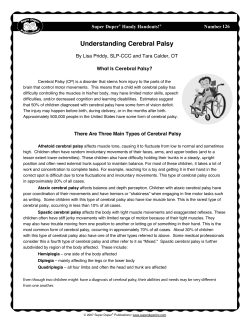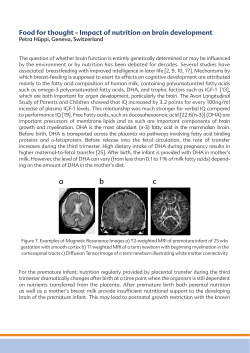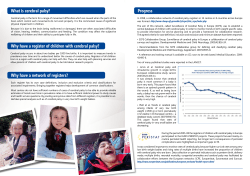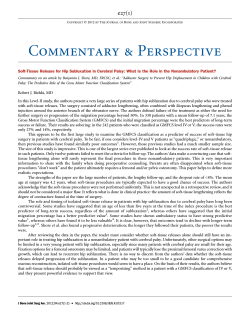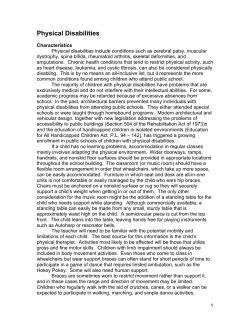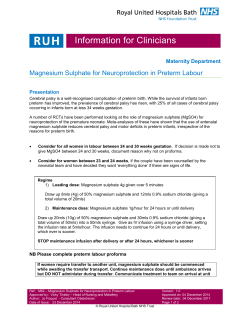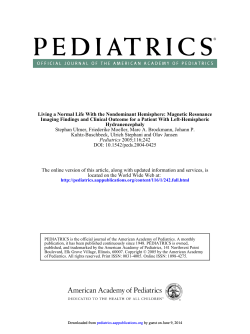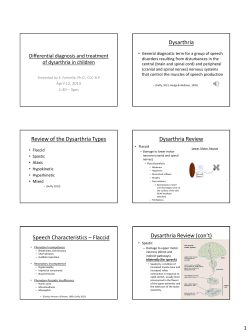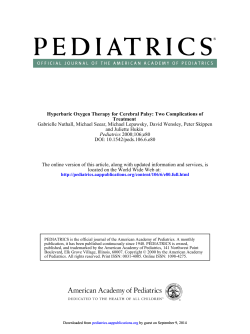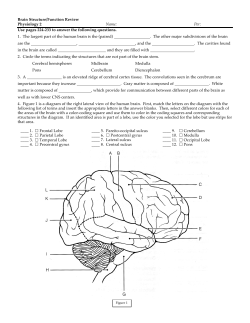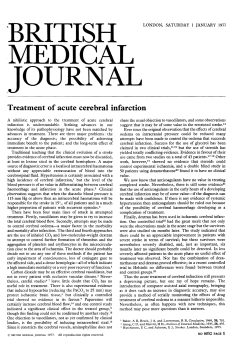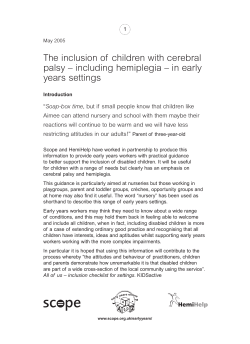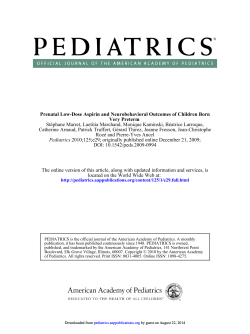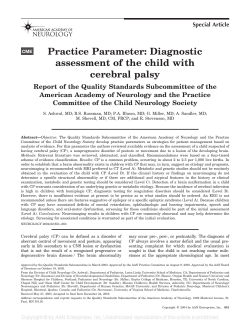
Noncystic white matter injury – ...
The Turkish Journal of Pediatrics 2007; 49: 426-430 Case Noncystic white matter injury – a case report Grażyna Hnatyszyn1, Lech Cyryłowski2, Maria Giżewska3, Anna Kabacińska4 Halina Konefał1, Danuta Jaroszewicz-Źrebiec5 Departments of 1Neonatology, 2Imaging Diagnostics and Interventional Radiology, 3Otolaryngology and Laryngological Oncology, and 4IInd Department of Children’s Diseases, Pomeranian Medical University, and 5Centre of Early Intervention, Szczecin, Poland SUMMARY: Hnatyszyn G, Cyryłowski L, Giżewska M, Kabacińska A, Konefał H, Jaroszewicz-Źrebiec D. Noncystic white matter injury – a case report. Turk J Pediatr 2007; 49: 426-430. Magnetic resonance imaging (MRI) of the brain in preterm infants at term–equivalent age demonstrated that apart from cystic periventricular leukomalacia (PVL), noncystic white matter injury may take place, detected as diffuse excessive high signal intensity (DEHSI) in the white matter on T2-weighted imaging. Magnetic resonance imaging of the brain is conducted in few neonatal intensive care units. Consequently, the literature on the subject lacks descriptions of sequelae of noncystic white matter injury in premature newborns with very low birth weight (VLBW). We present the results of a three-year long observation of a child born at the 27th week of pregnancy diagnosed with DEHSI. The boy exhibited cerebral palsy, hyperexcitability and hypoacusis. In the authors’ opinion, noncystic white matter injury may not just be one of the reasons for cognitive/behavioral deficits - it may also be responsible for some cases of cerebral palsy in premature infants. Key words: magnetic resonance imaging, diffuse excessive high signal intensity (DEHSI), brain, preterm, very low birth weight, developmental disabilities (disturbances). Premature newborns with very low birth weight (VLBW) constitute a group of children especially susceptible to developmental defects1. Improvement in perinatal care has resulted in a drop in incidence of cerebral palsy in VLBW infants (from 19% in the 1990s to approximately 10-11% nowadays)2-6. It is related to decreased frequencies of periventricular leukomalacia (PVL), germinal matrix-intraventricular hemorrhage, and posthemorrhagic hydrocephalus, which lead to cerebral palsy in premature newborns. However, currently conducted research indicates that about 50% of children with extremely low birth weight (ELBW) who exhibit symptoms of neither cerebral palsy nor mental retardation have mild neurological changes at pre-school and school age2,7-10. These include perceptual organization disorder, neurosensory impairment, poor attention, irritability, visuospatial and visual-motor disabilities, motor coordination disorder, and psychomotor and adaptation difficulties, which lead to school difficulties even in children with a normal intelligence quotient (IQ)8,11-18. Magnetic resonance imaging (MRI) of the brain in preterm infants, performed at the termequivalent age, showed diffuse excessive high signal intensity (DEHSI) in the white matter in T2-weighted scans, which did not correspond to white matter echogenicity on transfontanel ultrasound examination19-22. These abnormalities are found in as many as approximately 70% of examined ELBW newborns23. MR diffusionweighted images provided evidence that DEHSI is not linked to central nervous system (CNS) immaturity, but that it is a form of noncystic white matter injury23,24. Pathological examinations confirm the fact that the process corresponds to leukoencephalopathy and that pre-oligodendrocytes are the key Volume 49 • Number 4 Noncystic White Matter Injury 427 cellular target in this pathology25-29. According to Volpe2, the diffuse white matter injury may correlate with the cognitive/behavioral deficits in VLBW newborns. Case Report The authors present an offspring of middleage parents: 36-year-old mother, 35-year-old father, with no history of chronic disease in either. The mother’s obstetric history was complicated with one stillborn intrauterine pregnancy and one ectopic pregnancy. There were two older offspring developing properly. The boy was born vaginally at the 27th week of pregnancy, with birth weight of 1200 g. The pregnancy was complicated with an infection of the mother’s urinary system, intrauterine infection and placental abruption. The Apgar score was 4, 4, 5. The maturity of the baby according to Ballard’s scale was equivalent to 27th week of pregnancy. Because of severe respiratory distress syndrome observed from the first day of life, he received surfactant and assisted ventilation was applied. Symptoms of generalized infection, progressing with meningitis, thrombocytopenia, significant leukocytosis, and cholestasis (the culture of the blood, cerebrospinal fluid and discharge taken from endotracheal tube was positive for Staphyllococcus epidermidis) were also recognized. Additionally, the newborn was diagnosed with a congenital heart defect (ventricular septal defect, VSD), necrotizing enterocolitis, retinopathy of prematurity and subclinical hypothyroidism. Ultrasound of the brain performed in the first week of life detected grade 2 intraventricular hemmorhage, which was not present in follow-up examinations in the first month of life. A complex assessment of his neurological condition was carried out at approximately the 40th week of the baby’s conceptual age, including the assessment of the baby’s position, his spontaneous movement, muscle tonus, and primary reflexes, revealing that his neurological condition was equivalent to corrected age. Despite normal ultrasound of the brain, MRI demonstrated DEHSI on T2-weighted images corresponding to noncystic white matter injury (Fig. 1). Additionally, the baby was diagnosed with severe hearing loss (right ear-100 dB, left ear-80 dB), for which he was treated with hearing aids. Fig. 1. MRI of the head of the premature newborn at term. Axial T2-weighted image demonstrates diffuse excessive high signal intensity of white matter. Within the first six months of the baby’s life some neurological disturbances occurred. It was observed that the symmetrical tonic neck response and placing reflex continued longer than the physiological norm. These disturbances preceded the symptoms of increased tone in lower limbs and in one upper limb, which were detected after the sixth month of life. The cranial ultrasound carried out before each neurological examination showed mild lateral ventricular enlargement, increasing after the six month of life. The boy was rehabilitated according to NDTBobath’s method since the first months of life and has attended therapeutic sessions with a logopaedics specialist and a psychologist. His hearing loss was treated. At the end of his 1st corrected year, the boy was diagnosed with cerebral palsy in the form of mild-degree spastic diplegia. After having finished his second year, the boy regained his independent motion. He articulated separate, consciously pronounced words. At the same time, some psycho-motor hyperexcitability was observed. Another complex assessment of the boy’s neurological condition (including neurological, psychological, auditory brainstem response [ABR] examinations and MRI) was carried out at the end of his third year. The neurological 428 Hnatyszyn G, et al The Turkish Journal of Pediatrics • October - December 2007 examinations demonstrated hearing impairment, a slight weakening of the muscle strength in his right upper limb, excessive patellar reflex as well as positive Babinski’s sign in both lower limbs. The gait was independent, but ungraceful. The psychological examination after the third year revealed speech impairment, perceptual organization disorder, neurosensory impairment and irritability and hyperactivity. Small hypersensitive areas were demonstrated in the white matter of both parietal lobes in MRI on T2-weighted images, which could have been equivalent to earlier anoxic changes (Fig. 2). Additionally, in close proximity to the lateral wall of the lateral right cerebral ventricule, a thin–walled fluid lesion 1.3 cm x 1.5 cm in size was detected. The lesion could be related to the ventricular loculation (Fig. 3). Fig. 3. MRI of the head of the three-year-old boy with diffuse excessive high signal intensity diagnosed at term. Axial T2-weighted images demonstrate a thin-walled fluid lesion in close proximity of the right lateral ventricle which can be related to the ventricular loculation. Other disorders which may contribute to the development of cerebral palsy include PVL, periventricular hemorrhagic infarction, and major intraventricular hemorrhage. These abnormalities are well demonstrated in head ultrasound examinations 21,30-31 . However, cerebral palsy is also diagnosed in premature newborns without the sonographic findings described above. Fig. 2. MRI of the head of the three-year-old boy with diffuse excessive high signal intensity diagnosed at term. Axial T2-weighted images demonstrate high signal intensities only in the parietal white matter (small arrows) corresponding to noncystic white matter injury. Additionaly, a fluid lesion can be noted in close proximity of the right lateral ventricle (see also Fig. 3). The boy remains under the care of many specialists. He also needs observation related to possible future school difficulties. Discussion Premature newborns are a special group of newborns particularly susceptible to developing spastic diplegia later in life 1,2. In presented case, ultrasound examination of the boy in question showed only a mild hemorrhage of second degree, which resolved later. No feature related to increased periventricular echogenicity or cystic form of PVL was found. On the other hand, MRI of the brain confirmed noncystic white matter injury. A serial ultrasound examination carried out several months later showed mild widening of the frontal horns of the lateral ventricles, which was a symptom of cerebral atrophy related to the white matter injury. The ineffectiveness of transfontanel ultrasound examination in the diagnosis of noncystic white matter injury was demonstrated by other authors21,23. According to Volpe2, diagnosis of DEHSI can be responsible for developmental disturbances in VLBW newborns. Apart from developmental disturbances, our subject was diagnosed with a mild form of cerebral palsy. In spite of his very complex history (prematurity, general infection with meningitis, intrauterine hypoxia, postnatal hypoxia), the authors Volume 49 • Number 4 conclude that the noncystic white matter injury demonstrated in brain MRI is a sequela of his past history and is responsible not only for the boy’s developmental disturbances, but also for a mild form of cerebral palsy. To the best of our knowledge, no report on clinical sequelae of noncystic white matter injury has been available until now. Domizio et al.32 were the first who reported results of the twoyear follow-up in 16 term children diagnosed with DEHSI: half of them had severe and mild mental impairment, and 10 children had severe and mild motor deficits; one child presented with seizures. Their results suggested that DEHSI in preterm newborns is not related to white matter immaturity, but can be considered as a form of the white matter injury. Taking into consideration the frequency of mild developmental disturbances and DEHSI in VLBW newborns, it is possible that noncystic white matter injury may be responsible for developmental disturbances in this group of children2. Our subject with DEHSI presented developmental disorders and cerebral palsy in his further development. The above presented case also points to a fact that DEHSI diagnosed with MRI may explain the presence of cerebral palsy in newborns in whom cranial ultrasound failed to detect cystic forms of PVL, periventricular hemorrhagic infarction, major intraventricular hemorrhage or hydrocephalus. We believe that more reports describing the development of newborns with noncystic white matter injury are necessary. REFERENCES 1. Tommiska V, Heinonen K, Ikonen S, et al. A national short-term follow-up study of extremely low birth weight infants born in Finland in 1996-1997. Pediatrics 2001; 107: E2. 2. Volpe JJ. Cerebral white matter injury of the premature infant - more common than you think. Pediatrics 2003; 112: 176-180. 3. Bracewell M, Marlow N. Patterns of motor disability in very preterm children. Ment Retard Dev Disabil Res Rev 2002; 8: 241-248. 4. Salokorpi T, Rautio T, Sajaniemi N, Serenius-Sirve S, Tuomi H, von Wendt L. Neurological development up to the age of four years of extremely low birthweight infants born in Southern Finland in 1991–1994. Acta Paediatr 2001; 90: 218-221. 5. Tommiska V, Heinonen K, Kero P, et al. A national two year follow up study of extremely low birthweight infants born in 1996-1997. Arch Dis Child Fetal Neonatal Ed 2003; 88: F29-35. Noncystic White Matter Injury 429 6. Wood NS, Marlow N, Costeloe K, Gibson AT, Wilkinson AR. Neurologic and developmental disability after extremely preterm birth. EPICure Study Group. N Engl J Med 2000; 343: 378-384. 7. Cooke RW, Abernethy LJ. Cranial magnetic resonance imaging and school performance in very low birth weight infants in adolescence. Arch Dis Child Fetal Neonatal Ed 1999; 81: F116-121. 8. Grunau RE, Whitfield MF, Davis C. Pattern of learning disabilities in children with extremely low birth weight and broadly average intelligence. Arch Pediatr Adolesc Med 2002; 156: 615-620. 9. Saigal S, den Ouden L, Wolke D, et al. School-age outcomes in children who were extremely low birth weight from four international population-based cohorts. Pediatrics 2003; 112: 943-950. 10. Skranes JS, Vik T, Nilsen G, et al. Cerebral magnetic resonance imaging and mental and motor function of very low birth weight children at six years of age. Neuropediatrics 1997; 28: 149-154. 11. Anderson P, Doyle LW, Victorian Infant Collaborative Study Group. Neurobehavioral outcomes of schoolage children born extremely low birth weight or very preterm in the 1990s. JAMA 2003; 289: 3264-3272. 12. Brown KJ, Kilbride HW, Turnbull W, Lemanek K. Functional outcome at adolescence for infants less than 801 g birth weight: perceptions of children and parents. J Perinatol 2003; 23: 41-47. 13. Downie AL, Jakobson LS, Frisk V, Ushycky I. Periventricular brain injury, visual motion processing, and reading and spelling abilities in children who were extremely low birthweight. J Int Neuropsychol Soc 2003; 9: 440-449. 14. Erikson C, Allert C, Carlberg EB, Katz-Salamon M. Stability of longitudinal motor development in very low birthweight infants from 5 months to 5.5 years. Acta Paediatr 2003; 92: 197-203. 15. Holsti L, Grunau RV, Whitfield MF. Developmental coordination disorder in extremely low birth weight children at nine years. J Dev Behav Pediatr 2002; 23: 9-15. 16. Jakobson LS, Frisk V, Knight MR, Downie AL, Whyte H. The relationship between periventricular brain injury and deficits in visual processing among extremelylow-birthweight (<1000 g) children. J Pediatr Psychol 2001; 26: 503-512. 17. Saigal S, Hoult LA, Streiner DL, Stoskopf BL, Rosenbaum PL. School difficulties at adolescence in a regional cohort of children who were extremely low birth weight. Pediatrics 2000; 105: 325-331. 18. Weindrich D, Jennen-Steinmetz C, Laucht M, Schmidt MH. Late sequelae of low birthweight: mediators of poor school performance at 11 years. Dev Med Child Neurol 2003; 45: 463-469. 19. Inder TE, Anderson NJ, Spencer C, Wells S, Volpe JJ. White matter injury in the premature infant: a comparison between serial cranial sonographic and MR findings at term. AJNR Am J Neuroradiol 2003; 24: 805-809. 20. Inder TE, Wells SJ, Mogridge NB, Spencer C, Volpe JJ. Defining the nature of the cerebral abnormalities in the premature infant: a qualitative magnetic resonance imaging study. J Pediatr 2003; 143: 171-179. 430 Hnatyszyn G, et al The Turkish Journal of Pediatrics • October - December 2007 21. Maalouf EF, Duggan PJ, Counsell SJ, et al. Comparison of findings on cranial ultrasound and magnetic resonance imaging in preterm infants. Pediatrics 2001; 107: 719-727. 27. Haynes RL, Folkerth RD, Keefe RJ, et al. Nitrosative and oxidative injury to premyelinating oligodendrocytes in periventricular leukomalacia. J Neuropathol Exp Neurol 2003; 62: 441-450. 22. De Vries LS, Groenendaal F, Meiners LC. Ischemic lesions in the preterm brain. In: Rutherford M (ed). MRI of the Neonatal Brain. London-Toronto: W.B. Saunders; 2002: 155-169. 28. Robertson CM, Svenson LW, Joffres MR. Prevalence of cerebral palsy in Alberta. Can J Neurol Sci 1998; 25: 117-122. 23. Counsell SJ, Allsop JM, Harrison MC, et al. Diffusionweighted imaging of the brain in preterm infants with focal and diffuse white matter abnormality. Pediatrics 2003; 112: 1-7. 24. Counsell SJ, Shen Y, Boardman JP, et al. Axial and radial diffusivity in preterm infants who have diffuse white matter changes on magnetic resonance imaging at term-equivalent age. Pediatrics 2006; 117: 376-386. 25. Back SA, Han BH, Luo NL, et al. Selective vulnerability of late oligodendrocyte progenitors to hypoxia-ischemia. J Neurosci 2002; 22: 455-463. 26. Hagberg H, Peebles D, Mallard C. Models of white matter injury: comparison of infectious, hypoxicischemic, and excitotoxic insults. Ment Retard Dev Disabil Res Rev 2002; 8: 30-38. 29. Volpe JJ. Neurobiology of periventricular leukomalacia in the premature infant. Pediatr Res 2001; 50: 553-562. 30. Flodmark O, Barcovich AJ. Imaging of the infant brain. In: Lagercranz H, Hanson M, Evrard P, Rodeck C (eds). The Newborn Brain. Cambridge: University Press; 2002: 289–316. 31. Ment LR, Bada HS, Barnes P, et al. Practice parameter: neuroimaging of the neonate: report of the Quality Standards Subcommittee of the American Academy of Neurology and the Practice Committee of the Child Neurology Society. Neurology 2002; 58: 1726–1738. 32. Domizio S, Barbante E, Puglielli C, et al. Excessively high magnetic resonance signal in preterm infants and neuropsychobehavioural follow-up at 2 years. Int J Immunopathol Pharmacol 2005; 17: 365-375.
© Copyright 2025
